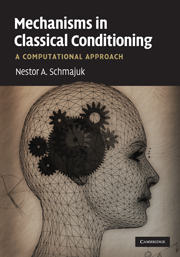Book contents
- Frontmatter
- Contents
- Preface
- Acknowledgments
- Abbreviations
- Part I Introduction
- Part II Attentional and associative mechanisms
- Part III Configural mechanisms
- Part IV Attentional, associative, configural and timing mechanisms
- 14 Configuration and timing: timing and occasion setting
- 15 Attention and configuration: extinction cues
- 16 Attention, association and configuration: causal learning and inferential reasoning
- Part V Conclusion: mechanisms of classical conditioning
- References
- Author Index
- Subject Index
16 - Attention, association and configuration: causal learning and inferential reasoning
from Part IV - Attentional, associative, configural and timing mechanisms
Published online by Cambridge University Press: 23 May 2010
- Frontmatter
- Contents
- Preface
- Acknowledgments
- Abbreviations
- Part I Introduction
- Part II Attentional and associative mechanisms
- Part III Configural mechanisms
- Part IV Attentional, associative, configural and timing mechanisms
- 14 Configuration and timing: timing and occasion setting
- 15 Attention and configuration: extinction cues
- 16 Attention, association and configuration: causal learning and inferential reasoning
- Part V Conclusion: mechanisms of classical conditioning
- References
- Author Index
- Subject Index
Summary
In this chapter, we apply the attentional–configural form of the SLG neural network model (see Chapter 15), which combines attentional, configural and associative mechanisms to the description of causal learning and inferential reasoning.
Causal learning
As described in Chapter 8, and according to associative theories (e.g. Rescorla & Wagner, 1972; the SLG model; and the SD/SLH model), blocking is the consequence of stimulus A winning the competition with X to predict the US, because the US is already predicted by A at the time of A–X–US presentations. In contrast, according to the inferential process view (see Beckers et al., 2006), blocking is the consequence of an inferential process based on the assumptions of additivity and maximality. Maximality refers to the evidence that the Outcome produced by each potential cause has not reached the maximal possible value. Additivity denotes the fact that two causes, each one independently producing a given Outcome, produce a stronger Outcome when presented together.
Supporting the inferential explanation, recent experimental results have shown that, both in humans (Lovibond et al., 2003; Beckers et al., 2005) and rats (Beckers et al., 2006), blocking was stronger if the maximal premise (the outcome of each cause does not reach the maximum possible value) and the additivity premise (the outcomes of effective causes can be added) are satisfied. In contrast, Beckers et al. (2005) showed that the Rescorla–Wagner (1972) model incorrectly predicts more blocking with an intense (maximal) than with a moderate (submaximal) outcome.
- Type
- Chapter
- Information
- Mechanisms in Classical ConditioningA Computational Approach, pp. 403 - 414Publisher: Cambridge University PressPrint publication year: 2010



